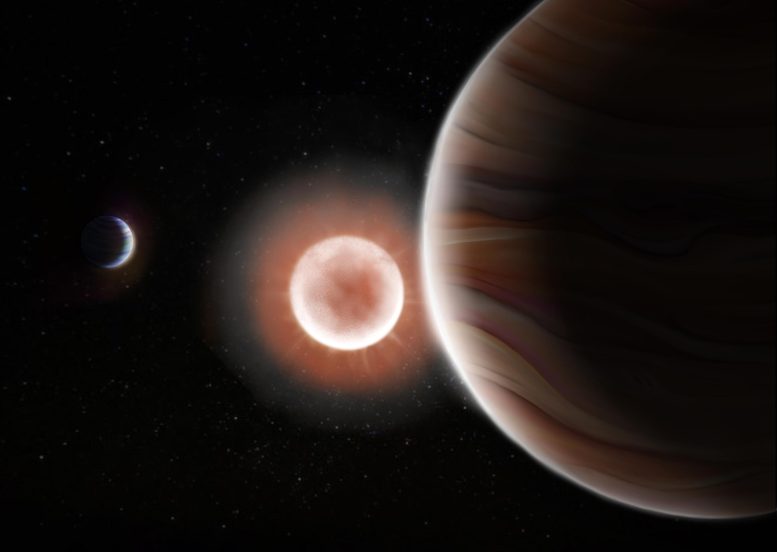
Scientists have discovered a unique system around a star, TOI-4600, containing two long-period planets. This artist’s rendition shows the two planets and star in the TOI-4600 system. Credit: Tedi Vick
Using TESS, scientists identified two long-period exoplanets, TOI-4600 b and c. These discoveries open new research avenues in understanding exoplanets, and the findings emphasize the significance of collaborative efforts, including contributions from amateur astronomers.
Scientists from The University of New Mexico (UNM), and Massachusetts Institute of Technology (MIT) have detected and validated two of the longest-period exoplanets found by TESS to date. These long-period large exoplanets orbit a K dwarf star and belong to a class of planets known as warm Jupiters, which have orbital periods of 10-200 days and are at least six times Earth’s radius. This recent discovery offers exciting research opportunities for the future of finding long-period planets that resemble those in our own solar system.
Research and Methodology
The research titled, “TOI-4600 b and c: Two long-period giant planets orbiting an early K dwarf” was published on August 30 in The Astrophysical Journal Letters. The exoplanets, TOI-4600 b and c, were detected using photometric data from the Transiting Exoplanet Survey Satellite (TESS) and followed up with observations using the telescopes on the ground since they provide better resolution.
The observing strategy adopted by NASA’s TESS, which divides each hemisphere into 13 sectors that are surveyed for roughly 28 days, is producing the most comprehensive all-sky search for transiting planets. This approach has already proven its capability to detect both large and small planets around different kinds of stars. In the case of TOI-4600, the star is a K dwarf star, also known as an orange dwarf, which are stars slightly smaller and cooler than the Sun.
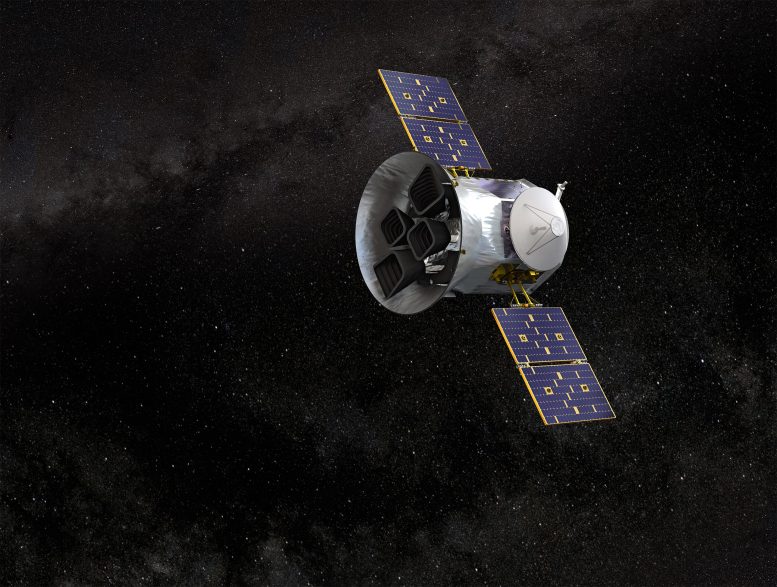
Illustration of NASA’s Transiting Exoplanet Survey Satellite (TESS). Credit: NASA’s Goddard Space Flight Center
Details of the Findings
Exoplanets must transit their host stars at least twice within TESS ‘s observing span to be detected with the correct period by the Science Processing Operations Center (SPOC) pipeline and the Quick Look Pipeline (QLP), which search the 2-minute and 30-minute cadence TESS data, respectively. Because 74 percent of TESS’ total sky coverage is only observed for 28 days, the majority of TESS exoplanets detected have periods less than 40 days. Therefore, TOI-4600 b’s 82.69-day, or nearly 3-month, and TOI–4600 c’s 482.82-day, or 16-month, periods make their discoveries even more valuable.
The University of New Mexico’s Ismael Mireles, the lead author of the paper, along with collaborators including Diana Dragomir, an assistant professor in UNM’s Department of Physics and Astronomy, and collaborators from Massachusetts Institute of Technology and University of Bern, analyzed the data in order to measure the periods and sizes of these planets.
Unique Characteristics of the Exoplanets
After initially detecting the transits, Mireles and team had to confirm that these were actual planets and to determine which signal the star was coming from. The diagnostic tools with TESS indicated that the signals coming from the target site were indeed on point. With help from TESS-Follow-up Observing Program (TFOP) Subgroup 1 (SG1), a global network of professional and amateur astronomers with access to telescopes small and large, they observed and watched a transit happen thus confirming for the researchers that this planet is indeed on target. Another factor that Mireles and his team had to consider were the masses and sizes of the planets. In order to achieve this they substituted the velocity measurements to observe how much the host star wobbles because the host star will pull on the planet.
“When we got the measurements, we were seeing very little movement in the target star. So when you start, you could be responsible for what we were seeing. Those two things together pretty much ruled it out. At that point we were sure that we had two planets,” Mireles stated.
The researchers found these two planets and the inner planet TOI-4600 b is 82.69 days with a radius that is around just under seven times Earth’s radius. It is between the size of Neptune and Saturn. This planet, TOI-4600 b, has an estimated temperature of about 170 degrees Fahrenheit, which is hot, but colder than a lot of the planets that astronomers have found. The second planet found, TOI-4600 c, is about nine and a half times Earth’s radius, meaning it is roughly Saturn-sized. It initially transited only once the first time TESS observed the star before transiting a second time almost 3 years later.
“Once you have two transits, you have an idea of what the periods can be. It could be the 965 days separating them, half of that, a third, a quarter, etc. The shorter periods could be ruled out because TESS had observed the star for a long time, so it only left two periods: 965 days or half of that,” explained Mireles. The researchers used a model developed by collaborator Hugh Osborn at the University of Bern to compare the possible orbital periods and determine which one was most likely, and found that half of 965, or 482.82 days to be precise, was more likely. TOI-4600 c’s 482.82-day period makes it the longest-period planet found by TESS to date and with a temperature of around -110 degrees Fahrenheit, it is one of the coldest planets found by TESS.
Comparative Analysis and Future Research
Katharine Hesse, TOI & vetting lead at MIT, collaborated with Mireles and the team on the data analysis from TESS. Hesse helped process and analyze the large amount of data and placed the system into the context of other multiple-planet systems that have been found by missions including TESS. The comparison of the TOI-4600 system with other discovered exoplanet systems helps explore features like the formation time and processes and helped the researchers begin to place this system in the broader context of exoplanet systems.
“The main thing is trying to uncover more about planet formation because based on what we know about the exoplanets we found, so far, nothing really looks like the solar system. The interesting thing is that we want to learn about this planet formation. We have over 5,000 exoplanets now, but none of these systems really look like the solar system. And so we want to find out how these different types of systems formed and migrated,” Mireles said. [ed. — New milestone just reached, 5,500 exoplanets.]
Mireles and researchers are interested in these findings because of the discovery of two long-period giant planets, which is a configuration that astronomers don’t often see, even though the solar system found had four giant long distances or a long period one. This prompts further research discussions and questions as Mireles points out, “We want to find out how these are formed? Are there other planets in this system? Does that tell us anything about how these giant planets affect smaller planets that might be in there or might not be in there and why they’re not there? There’s still things that we want to find out and that will tell us a lot about planet formation.”
In closing, Mireles promotes a call to action for citizen scientists, and hobbyists in astronomy, to participate and get involved in this research discovery. On Monday, October 16, there will be another possible transit opportunity coming up for those who are interested and want to observe it to further confirm that the period of the outer planet is indeed 482 days. People with even smaller telescopes could participate if they have the right tools. “There are people that are citizen scientists or amateur astronomers that have their own telescopes and help us with all these observations. There is a group of people with access to telescopes that are essentially confirming that a transit event is occurring on the star of interest,” said Mireles.
Involvement of Amateur Astronomers
“People, who are either retired or have a different day job but who are also amateur astronomers, are contributing very useful data to help verify these planets. The results that they are producing are of professional quality. The efforts of these committed citizen scientists are critical to the process of confirming these planets” Dragomir, assistant professor in UNM’s Department of Physics and Astronomy stated.
For more on this discovery, see TESS Discovers Longest-Orbit Exoplanet Yet.
Reference: “TOI-4600 b and c: Two Long-period Giant Planets Orbiting an Early K Dwarf” by Ismael Mireles, Diana Dragomir, Hugh P. Osborn, Katharine Hesse, Karen A. Collins, Steven Villanueva, Allyson Bieryla, David R. Ciardi, Keivan G. Stassun, Mallory Harris, Jack J. Lissauer, Richard P. Schwarz, Gregor Srdoc, Khalid Barkaoui, Arno Riffeser, Kim K. McLeod, Joshua Pepper, Nolan Grieves, Vera Maria Passegger, Solène Ulmer-Moll, Joseph E. Rodriguez, Dax L. Feliz, Samuel Quinn, Andrew W. Boyle, Michael Fausnaugh, Michelle Kunimoto, Pamela Rowden, Andrew Vanderburg, Bill Wohler, Jon M. Jenkins, David W. Latham, George R. Ricker, Sara Seager and Joshua N. Winn, 30 August 2023, The Astrophysical Journal Letters.
DOI: 10.3847/2041-8213/aceb69

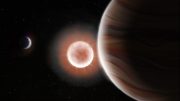
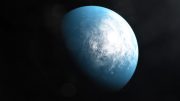
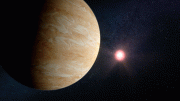
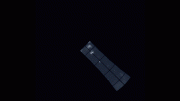
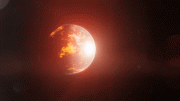
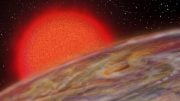
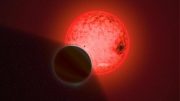
Be the first to comment on "Astronomers Uncover Exoplanet With an Unprecedented Orbit"